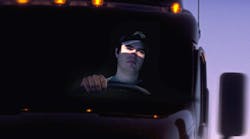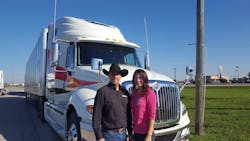Driving at night has its advantages such as less traffic and more open parking spaces in the morning. But it has its drawbacks, too, the main one being that humans are hardwired to be up during the day and sleep at night.
"It’s important to understand that your body will never fully adapt to working overnight," says Nancy Grugle, who got her Ph.D. about studying the effects of sleep deprivation on human performance. She currently works as an expert courtroom witness for plaintiff and defense sides concerning sleep deprivation, fatigue, and drowsy driving.
There are some things that drivers who work at night can do to help, but it's not what most people think they are. Rather than focus on techniques for staying alert at night, like using caffeine or sugar drinks, opening windows and playing loud music, she says it's more important to get the best sleep you can during the day.
"It’s very difficult to block out the real world during the day, but it’s important to get your sleeping conditions as ideal as possible," she says. "[Have a] completely dark room, no sounds if you can avoid it, no interruptions, no people coming in asking you to do things. Hopefully, you can block out lawnmowers and whatever other activities are going on outside. But it’s also important to understand that even if you are getting the same number of hours of sleep, the quality of your sleep is not going to be the same as if you were sleeping at night."
Todd Sturgis and his wife Tamera drive as a team and he has some tricks that he uses to drive at night while his wife sleeps.
"My hours change," he says. "Sometimes I’ll start at 7 p.m. Sometimes I’ll start at 9 p.m., which makes it much more difficult [to get acclimated]. Driving at night is difficult in and of itself, and having a rotating night shift is extremely difficult."
He drives about 60% at night; his wife drives about 40% at night.
"We’re out of Tulsa, OK, and we haul a lot of Amazon freight, which can be difficult for a team because they’re shorter runs. So you’re jogging. You’re talking to the guard at the gate and the person in the sleeper can hear it. You’re unhooking and hooking and you can hear it in the bunk and feel it, too. Amazon’s great. They’re in and out and they’re always on time, so they’re a great company for that, but the length of their runs are eight hours, so you’re kind of waking up your partner."
How does he adjust to the changing work times?
"The main thing is you don't," says Sturgis. "You push as long as you can and then you get a day of rest, and that’s my 34-hour restart."
He tends to run the interstates, big city to big city, on a 10-hour shift. He's familiar with his routes which he's been driving for about 25 years. He appreciates the quiet roads with fewer vehicles at night. In general, he enjoys night driving, but it takes planning. "I try to make my shift as stress-free as possible by knowing my route and where I'm going to fuel."
He suggests: "If you can, if you run a semi-dedicated evening and you’re on the same five interstates, try to remember rest areas where you can take a 20-minute nap. Here’s something really important that I do; there's an app called Trucker Path, and it gives me the rest areas. If I’m feeling tired and I’m thinking maybe in three hours I need a nap, I get on Trucker Path. I look and see about the nearest rest area truck stop to where I will be. You can often park on the off ramp if you have to. I’ll know that in three hours I’ll probably be tired, and I have my location planned out and I’m going to take a 20- or 30-minute nap, and that really helps. That app, listening to YouTube programs, and stimulants (energy drinks because he's allergic to coffee) and then you just hope for a day of rest, a 34-hour restart."
Henry Albert also drives nights when he has to, often starting at 7 or 9 p.m. and “basically rolling 'til the sun comes up."
He owns his own truck and does OTR. To prepare for the night shift he changes his sleep times. "The last night I stay up way later so that I know that I’ll sleep during the day and be closer to that schedule as soon as I start on it. It’s not really that hard."
He says that some drivers get into trouble when they try to stay up too long and not get enough sleep. "It’s trying to burn the candle at both ends, still keep your day and be up at night. You can do it for a short period of time but then it will catch you."
He notes that it's important to take an extra break somewhere between 3 and 6 a.m., which is parallel to the day time afternoon period when most people experience fatigue.
To help stay more alert for night driving he puts on his headset and talks with friends working the same shift.
Albert, who has been on the road since 1983, says that drivers get into trouble when they're not expecting to work nights and it's not part of their plan. "They're already aggravated, possibly from being up all day waiting to be dispatched, anticipating being dispatched or hung up at a shipper's dock and trying to sleep. They're starting out letting that aggravation of the day get to them. They're fatigued from being aggravated."
The most difficult part of night driving? "Probably the hardest nights are when it’s a moonless, starless dark night. That gets old pretty quick," Albert notes. "It’s almost like you’re driving into a black hole."





